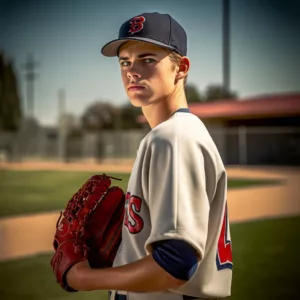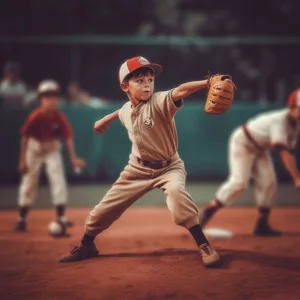 Pitching Rules Little League across the world are governed by Regulation VI and Rule 8.00 of the Little League® Rule Book. This extra guide was created to emphasize and clarify many of the provisions found in these regulations. The rules contained in this supplement are not exhaustive, and the Little League® Rule Book should be reviewed for a complete list of restrictions. Please keep in mind that these rules apply only to regular season games. Pitching regulations for International Tournament play can be found in the Little League® Rule Book.
Pitching Rules Little League across the world are governed by Regulation VI and Rule 8.00 of the Little League® Rule Book. This extra guide was created to emphasize and clarify many of the provisions found in these regulations. The rules contained in this supplement are not exhaustive, and the Little League® Rule Book should be reviewed for a complete list of restrictions. Please keep in mind that these rules apply only to regular season games. Pitching regulations for International Tournament play can be found in the Little League® Rule Book.
Pitching Violation Penalty
- Any breach of Regulation VI may result in a protest of the game in which it happens. Protests must be submitted in line with Rule 4.19. - Article VI(h)
- Withdrawing an ineligible pitcher after the pitcher has been announced or after a warm-up pitch has been given, but before that player has pitched a ball to a batter, is not a violation. When a protest is anticipated, the potential offender should be told right away. Note 1 to Regulation VI
- Minors and Majors: If a pitcher is proven to be ineligible while warming up, he or she must be removed, and the prior pitcher of record may not return. Note 1 to Regulation VI
Little League Rules Pitching by League Age
| AGE | PITCHES PER DAY |
|---|---|
| 6-8 | 50 Pitches |
| 9-10 | 75 Pitches |
| 11-12 | 85 Pitches |
| 13-16 | 95 Pitches |
Little League Rules Pitching by Days Rest Thresholds
| PITCHES | REST | AGE |
|---|---|---|
| 1-20 | 0 Days | 14 and Under |
| 21-35 | 1 Day | 14 and Under |
| 36-50 | 2 Days | 14 and Under |
| 51-65 | 3 Days | 14 and Under |
| 66+ | 4 Days | 14 and Under |
| 1-30 | 0 Day | 15 & 16 |
| 31-45 | 1 Day | 15 & 16 |
| 46-60 | 2 Days | 15 & 16 |
| 61-75 | 3 Days | 15 & 16 |
| 76+ | 4 Days | 15 & 16 |
Pitching Rules Little League of Consecutive Days
Regulation VI(d) A player shall not pitch on three (3) consecutive days under any circumstances.
Regulations VI(c) and VI(d) require the completion of the batter
 If a pitcher approaches a limit or rest threshold while facing a batter, he or she may pitch until one of the following events occurs: 1) that batter advances to second base; 2) that batter is retired; 3) the third out is made to end the half-inning or game; or 4) the pitcher is removed from the mound before the hitter completes his/her at bat. The first pitch thrown to a batter determines a pitcher's pitch count for the purposes of the day(s) rest threshold. Once the limit specified by Regulation VI(c) has been reached, the pitcher may not start a new batter.
If a pitcher approaches a limit or rest threshold while facing a batter, he or she may pitch until one of the following events occurs: 1) that batter advances to second base; 2) that batter is retired; 3) the third out is made to end the half-inning or game; or 4) the pitcher is removed from the mound before the hitter completes his/her at bat. The first pitch thrown to a batter determines a pitcher's pitch count for the purposes of the day(s) rest threshold. Once the limit specified by Regulation VI(c) has been reached, the pitcher may not start a new batter.
Catcher/Pitcher - Rule VI(a)
- A pitcher who throws 41 or more pitches in a game is ineligible to play catcher for the rest of the day. The "Finish the Batter" Threshold Regulation now applies to Pitchers Switching to Catcher if they start their last batter with 40 pitches or less.
- A player who plays catcher for four (4) innings or more in a game is ineligible to pitch on that calendar day. Receiving one pitch to a batter in the fourth inning equals four (4) innings caught. Warm-up pitches do not count toward innings caught; only when the ball is live do pitches count toward innings caught.
- A player who has played catcher for three (3) innings or fewer, moves to pitcher, and throws 21 pitches or more (15- and 16-year-olds: 31 pitches or more) in the same day may not return to catcher on that calendar day. This regulation is subject to the "Finish the Batter" Threshold Regulation if they start their last batter with 20 or fewer pitches (30 or fewer for 15- and 16-year-olds).
Regulation VI(b) and Rule 3.03(c) Return to the Mound
- Minors & Majors: A pitcher who is pulled off the mound cannot return. If a pitcher is proven to be ineligible while warming up, he or she must be removed, and the prior pitcher of record may not return.
- Intermediate & Seniors: A pitcher who remains on defense but moves to a different position during the game may return as a pitcher at any time throughout the balance of the game, but only once per game.
Regulation VI(k) requires double headers
- Minors, Majors, and Intermediate: A player may only throw in one game per day.
- Juniors and seniors: A player may pitch in up to two games in a day if he or she pitched 30 pitches or less in the first game. That pitcher starts game 2 with the same pitch count as he or she finished game 1. The total amount of pitches a pitcher may throw in both games equals the daily limit of 95. If the pitchers start their last hitter in Game 1 with 30 or fewer pitches, the "Finish the Batter" Threshold Regulation now applies to this regulation.
Pitching Rules Little League: Warm Ups
- Pitchers will be given a total of eight (8) warm-up pitches or one (1) minute between innings. – Rule 8.0(3)
- Managers, coaches, and other adults are not permitted to warm up pitchers on the mound or in the bullpen. Only uniformed players are permitted to warm-up pitchers on the mound or in the bullpen. - Rule 3.09: The uniformed player shall wear a protective cup and mask.
Pitching Rules Little League: Mound Visits
 Majors, Intermediate, and Seniors: A manager or coach may come out once in an inning to visit with the pitcher, but the player must be removed as a pitcher the second time out. A manager or coach may enter the game twice to consult with the pitcher, but the player must be removed as a pitcher the third time. A pitcher who changes positions and returns as the pitcher of record must keep the number of visits from their prior appearance as a pitcher. - Rules 8.06(a) and (b).
Majors, Intermediate, and Seniors: A manager or coach may come out once in an inning to visit with the pitcher, but the player must be removed as a pitcher the second time out. A manager or coach may enter the game twice to consult with the pitcher, but the player must be removed as a pitcher the third time. A pitcher who changes positions and returns as the pitcher of record must keep the number of visits from their prior appearance as a pitcher. - Rules 8.06(a) and (b).- Minors: A manager or coach may come out twice in an inning to visit with the pitcher, but the player must be removed as a pitcher the third time out. A manager or coach may enter the game three times to consult with the pitcher, but the player must be removed as a pitcher the fourth time. - Rules 8.06(a) and (b).
- A manager or coach may not make a third visit while the same batter is at bat. - Rule 8.06(c)
- Any non-injury related time out to talk with any defensive player, as well as any visit to the mound between innings during an existing pitcher's warm up, is charged as a mound visit to the pitcher. - Rule 8.06(d)
- When a manager takes a timeout to make a pitching change, it is not deemed a visit to the pitcher if the pitching swap is made prior to meeting with any defensive player. - AR Rule 8.06
Pitching Rules Little League: Walking on Purpose
 Minors and Majors: The defensive manager may choose to deliberately walk a batter by informing the plate umpire of his choice. The umpire must first allow time, and the manager must notify the umpire of the intention to walk the batter. The request can be made before or during a game. The pitch count will be increased by the number of "balls" required based on the batter's count at the time of the manager's request to complete the Intentional Walk. - Rule 6.08(a)(2)
Minors and Majors: The defensive manager may choose to deliberately walk a batter by informing the plate umpire of his choice. The umpire must first allow time, and the manager must notify the umpire of the intention to walk the batter. The request can be made before or during a game. The pitch count will be increased by the number of "balls" required based on the batter's count at the time of the manager's request to complete the Intentional Walk. - Rule 6.08(a)(2)- Intermediate and Senior: The pitcher must intentionally deliver four balls to the batter. There is no such thing as an automatic walk. The catcher must begin each pitch in the catcher's box and cannot leave until the pitch has left the pitcher's hand. If the catcher is not in the catcher's box, the pitch is considered unlawful and a balk is called. - Rule 4.03(a)
Pitching Rules Little League: Pitching Signs
- Pitching signs must be issued by the catcher. Pitching signs cannot be given directly to pitchers by coaches - Rule 8.01 (updated 1/9/2022).
- Unsportsmanlike behavior includes stealing and relaying signs to notify the hitter of pitch selection and/or placement. If this behavior is observed by the umpire, the team management and individuals responsible, including any player(s) and/or coach(es), will be cautioned after the first infraction. For a team's subsequent transgression, those responsible, including any player(s), coach(es), and/or manager, will be expelled from the game.
Pitching Rules Little League: Suspended Games
(Rule 9.01(d)) Pitchers of record at the time the game was interrupted may continue to pitch to the extent of their eligibility for that day in suspended games resumed on another day, providing said pitcher has observed the required days of rest. Note 3 to Regulation VI


 Majors, Intermediate, and Seniors: A manager or coach may come out once in an inning to visit with the pitcher, but the player must be removed as a pitcher the second time out. A manager or coach may enter the game twice to consult with the pitcher, but the player must be removed as a pitcher the third time. A pitcher who changes positions and returns as the pitcher of record must keep the number of visits from their prior appearance as a pitcher. - Rules 8.06(a) and (b).
Majors, Intermediate, and Seniors: A manager or coach may come out once in an inning to visit with the pitcher, but the player must be removed as a pitcher the second time out. A manager or coach may enter the game twice to consult with the pitcher, but the player must be removed as a pitcher the third time. A pitcher who changes positions and returns as the pitcher of record must keep the number of visits from their prior appearance as a pitcher. - Rules 8.06(a) and (b).

In the Little League Major Division my pitches pitching the last game of the regular season 9-12 league and throws 50 pitches. Is he available to pitch the next day for the start of the League Playoffs. The question regarding tournament play, mypitcher pitches in the District tournament division we win the district and he throws 50 pitches that day can he pitch the FIRST game of the Sectional on the next day.